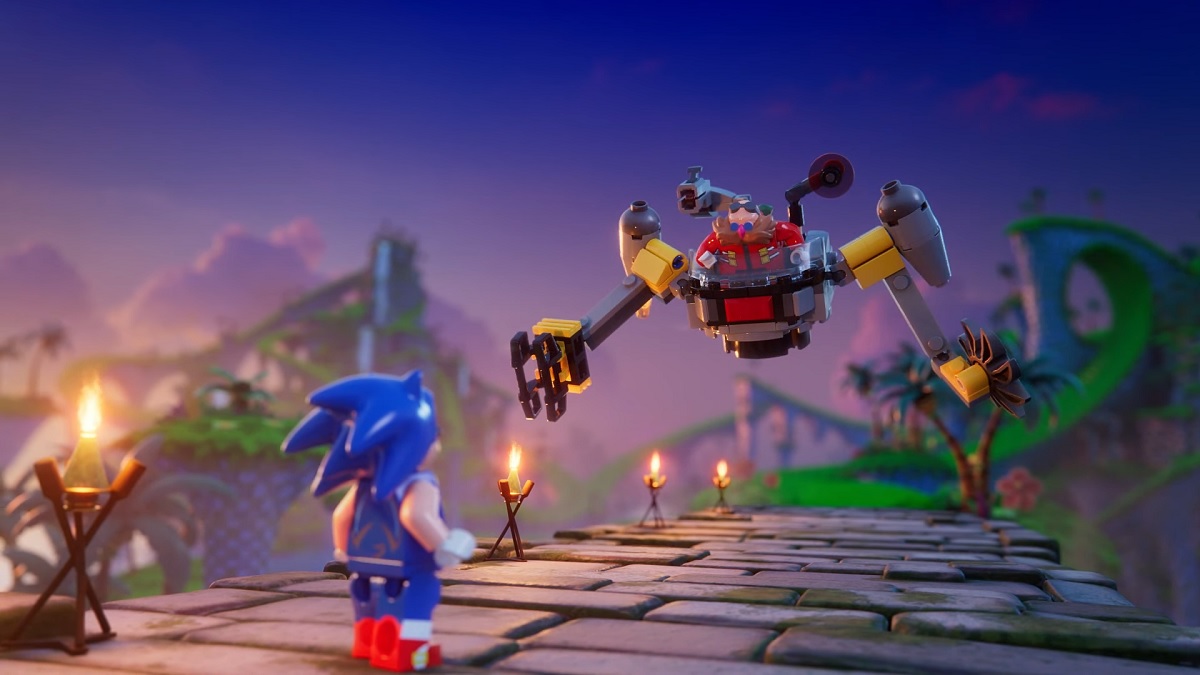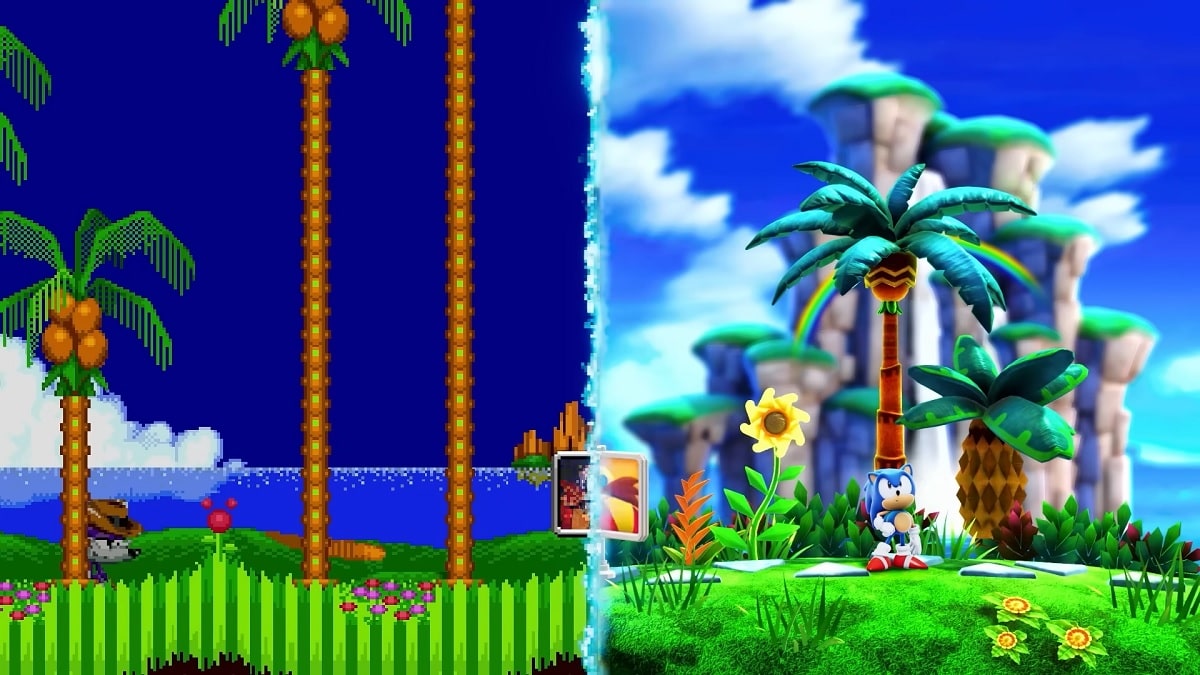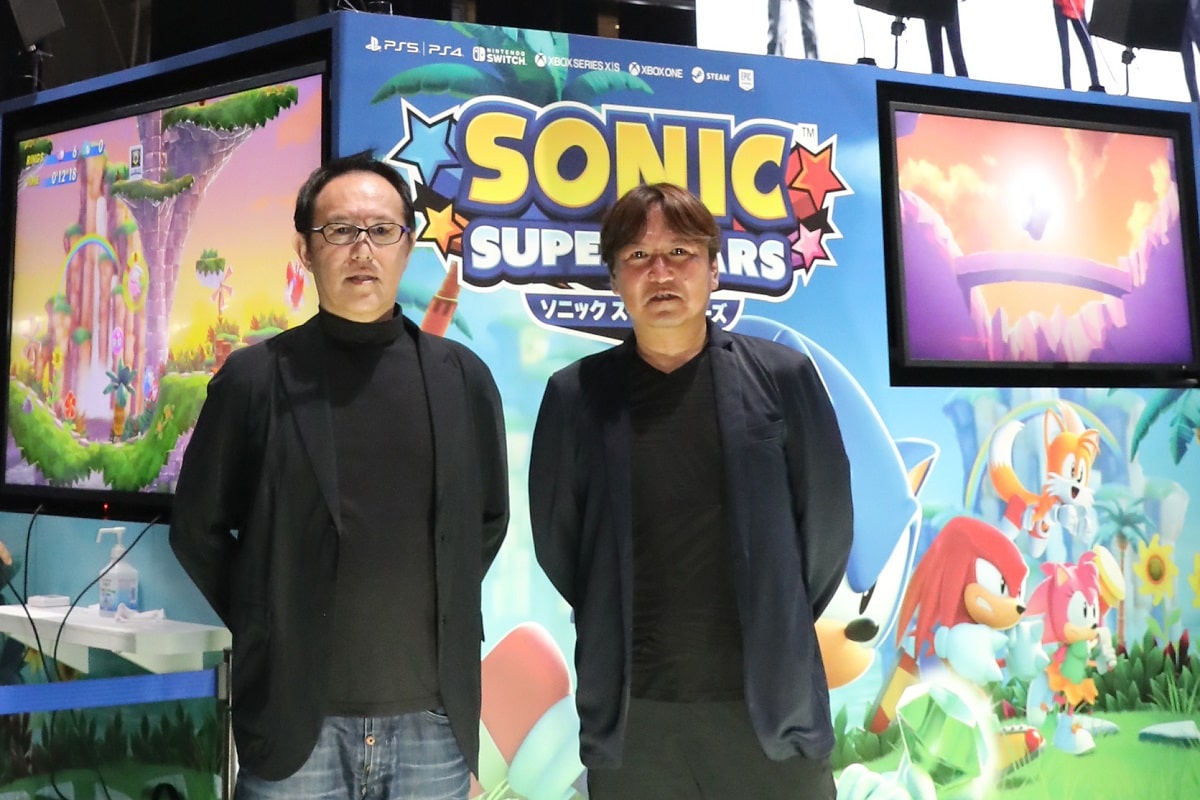Sega’s high-speed action game Sonic Superstars is set for release on October 17. The newest addition to the Sonic series will be a 2D side-scrolling platformer, much like the games of the “classic” Sonic the Hedgehog series. Sonic Superstars will revive the gameplay and feel of the series with new and evolved 3D graphics and the addition of a multiplayer mode.
During Tokyo Game Show 2023, our Japanese editorial team had the opportunity to interview the producers of the title, Takashi Iizuka of Sega of America and Naoto Oshima of Arzest. The following article summarizes some of the highlights of the original interview.

Recent editions to the Sonic series include the highly successful 3D platformer Sonic Frontiers from 2022 and the Sonic the Hedgehog movie from 2020, which had received mixed reviews. Looking back on the previous releases, Iizuka commented that for Frontiers, the success lied in the numerous play tests performed at various stages of development. The game was created while incorporating feedback of not only team members but regular players as well, which is why Iizuka was confident in the release.
On the topic of the mixed reactions in response to the trailer of Sonic Frontiers that was revealed before the game’s release, Iizuka mentions that “it was to the point of ‘Sonic cycle,’ a term that refers to the cycle of “being excited upon the announcement but being disappointed upon release” being coined by the fandom.” He comments that, although the game was subject to all kinds of scrutiny when the trailer was revealed, he was still confident that anyone who actually played it would recognize its quality, and thus made it his goal for Frontiers to have as many people try out and interact with the game through events such as TGS and Gamescom.

Moving onto the topic of Sonic Superstars, Iizuka comments about Sonic’s character and concept this time around. Throughout the Sonic series, he explains, Sonic’s character has had a dual nature – a cool side and a cute, cheeky side, which has led to changing trends in what aspect should be pursued. This was solved by viewing the series as two – the modern, 3D series and the classic, 2D series. In the modern series, Sonic is more of a cool character, while the classic series displays his cute side, closer to the original Sonic. In Superstars, it was decided to go for a light, poppy approach i.e., to portray the cute Sonic.
The Sonic Superstars project initially originated from Iizuka’s wish to create a new “classic” Sonic title, inspired in particular by the success of Sonic Mania from 2017. As Superstars will be the first 2D sonic title since Sonic Mania (excluding remakes), Iizuka emphasized that he does not view this as “going back to 2D,” but rather as continuing to pursue both 2D a 3D as two “main pillars” of the Sonic series, as the 2D action games and 3D action games both have their respective value.

When asked about the recently soaring popularity of the Sonic series, Iizuka once again goes back to Sonic Mania, rather than the Sonic movie, saying that it was Sonic Mania that revived the zeal of Sonic fans, after which the movie came. He mentions, “We changed Sonic’s appearance in the Sonic the Hedgehog movie thanks to fans speaking out. I think this was partly due to Sonic Mania reigniting fans’ “mania” for Sonic. In this sense, the fans are our most reassuring allies, and we’re always being careful not to betray them.” Even with the release of the movie, had there been no Sonic Mania, the popularity of Sonic would not be what it is now, he emphasizes.

Discussing the challenges that came with creating Sonic Superstars, a classic game but with new elements such as 3D models and multiplayer support, Iizuka revealed how the game had to be created entirely from scratch, as previous titles of the classic series all used the same Mega Drive engine and pixel art. All the movements and actions previously expressed in pixel art had to be reproduced with 3D models, and since it was not possible to reuse previous code, the process consisted of a lot of painstaking eyeballing. In turn, creating the 3D program has opened up the possibilities for further development of the classic series in the future.
Special attention was also required due to the fact that the 3D models needed to travel within 2D space. Oshima explains, “For example, if you have a loop in 3D space, the end of the loop switches into another lane, but in the game, we had to have the loop return into the same lane, so we had to be creative in pulling this off. If you think about it, it would have been simpler to just make a 3D game (laughs) but if it weren’t 2D, the whole feel of it would have been different.”

Expanding on why they put so much effort into making the game 2D, Oshima mentions that he finds the beauty of 2D games to be in tuning your senses to in-game movement, making any gap between what the player imagines and feels “unforgivable,” while Iizuka emphasizes the importance of staying through to the classic series.
On the other hand, Oshima also mentions one “deviation” from the classic 2D sonic games: In Superstars, the standard first level, the Green Hill Zone, has been replaced by a new starting stage, the Bridge Island, which has a different atmosphere to it. The game also incorporates new ideas from younger staff, such as the Cyber Space stage where the characters turn into pixel art rockets. Iizuka comments, “Having the characters change into various forms is something we hadn’t done with Sonic up until now. I found those kinds of ideas from the young staff wonderful.”

The multiplayer mode integrated this time around is also quite specific, and Oshima mentions a “whole lot of trial and error” going into it. The biggest challenge in development was avoiding the situation of players having to wait for each other and the game’s pace slowing down, making the game “unsonic-like.” As a result, they developed the 4-player multiplayer mode in which players may proceed ahead completely at their own pace, and those who get left behind get automatically transported to catch up.

Incidentally, Nintendo’s Super Mario Bros. Wonder was announced for release on October 20, which is very close to the release date of Sonic Superstars. Commenting this, Iizuka says, “I was definitely not expecting them to release in the same week (laughs) It was quite a surprise.” He goes on to mention how, although Mario and Sonic are both representative series of the side-scrolling action genre, their appeal is distinctly different, with Mario having its unique “Mario-style” and Sonic having its own “Sonic Style.” He adds that the fact that Sonic games have continuously been loved for 30 years is proof of the “Sonic-style” being recognized.
As mentioned previously, this article summarizes certain highlights of the interview originally conducted in Japanese. Those who wish to read the full story and precise details may refer to the original interview.
Sonic Superstars is scheduled for release on October 17 for the PC (Steam/Epic game store)/PS5/PS4/ Nintendo Switch/Xbox Series X|S/Xbox One.
Written by. Amber V based on the original Japanese article (original article’s publication date: 2023-09-28 13:30 JST)





